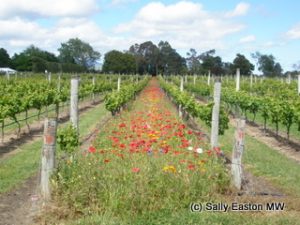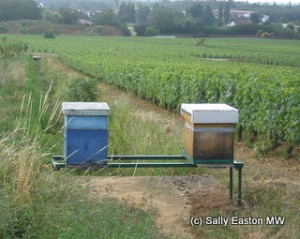A guide to the sustainability guides
A version of this article first appeared in Harpers Wine and Spirit Trades Review, January 2012.

New Zealand
As the need to take better care of the planet increases, sustainability issues have moved onto the agenda. Production/environment-led systems, such as organics and biodynamics, don’t necessary consider the broader remit of sustainability which involves the triple bottom line of environment, plus people (social equity) and economic sustainability. It’s often referred to as the three Es.
What’s clear is demand is on the up. Vintage Roots director Neil Palmer has seen demand increasing over the last two to three years. And importers Hallgarten Druitt are upgrading their website to include “vegetarian, organic and biodynamic [certified status] for 1,200 wines” said Beverly Tabbron MW, their purchasing director.
Even the Wine Society has a list of their organic and biodynamic wines. Ewan Murray said “our customers are increasingly interested. If members enquire we can answer them, but we don’t do it formally.”
Certification “was to prove we are actually doing it.” Drouhin
As sustainability moves higher up the agenda traceability becomes increasingly relevant, and certification of practices is a logical route, so both trade and consumers can verify sustainable claims. Palmer said “certification shows commitment and without it there is no clarity or proof for consumers.” And Burgundy’s Joseph Drouhin certified organic in 2006, after many years of practice. Philippe Drouhin said “it changed nothing but the paperwork and the expense. It was to be able to prove we are actually doing it.”
Frédéric Grappe, of Dynamic Vines, agreed, saying “some producers are still reluctant to put certification on the label. A lot of our producers work organically or biodynamically to produce better quality wine. They don’t do so to advertise themselves as part of a trend.”
In France lutte raisonée is often used synonymously with agriculture raisonnée, or viticulture raisonnée (VR), but this can be meaningless as an effective environmental tool as there’s no official definition, charter of practices or certification requirement. However, VR is an officially recognised system. Confusingly it can be partially adopted, or it can be certified to minimum standards, so the right questions need to be asked.
Certified VR practitioners adhere to a 90-point reference, including product control, health and safety and cellar hygiene, so it considers more than one ‘E’ of the triple bottom line. Domaine Coste-Caumartin certified VR in 2009. Owner Jérôme Sordet said “Before I certified, on average I made 12 sprays, now it’s about 8 sprays.”
By encouraging farmers to think about their practices and record them VR is a good foundation on which to build greater sustainability, and some growers do much more than the minimum requirement.
“We’re doing our bit of environmental stewardship.” New Zealand Winegrowers
VR is also potentially a nationwide system in participating European nations, but the new world is gaining clear ground with countrywide initiatives. New Zealand has been driving the ‘clean, green land’ message for 15 years. David Cox, director – Europe for New Zealand Winegrowers said “consumers are questioning products. Retailers and gatekeepers tell us people are interested. People are more concerned about what’s in products, and we need to show consumers we’re doing our bit of environmental stewardship. And even if consumers aren’t interested, we’re doing it because that’s the way we are, and because it’s got to be done.”

Beehives in Burgundy
Chile is the latest country, this year, to initiate a potentially nationwide scheme. Michael Cox, Europe director for Wines of Chile, said “the code encompasses practices that cover sustainable farming, social responsibility, energy efficiency, water conservation, and economic viability. This holistic approach will benefit Chilean wine lovers the world over, but more importantly will protect Chile and its people.”
With all such schemes, comparison is tricky. Elena Carretero, Santa Rita’s vice president of corporate affairs and sustainability, and a director of the Wines of Chile sustainability program, said “we have the same concept as [other countries], agreeing a common standard, but the viticultural practices in Chile are not the same as in Australia for example. Our oenologist practices are not the same as in California. The code has to be specific for our specific needs.” South Africa’s IPW system for example, has a strong biodiversity element, which is no surprise given the Cape floral kingdom, in which the winelands are located, is a biodiversity hotspot, accounting for 20% of the African continent’s flora in just 0.5% of the continent’s area.
Another challenge of getting to grips with sustainability issues is that the standards must not remain fixed. It’s not enough to say that a code, or a certification, exists. If it doesn’t change – the pass mark get tougher, the tolerances tighter – over time, these codes become fatuous.
Method Initiatives
Organic
Many producers infer organic principles, but certified standards and rules of production exist, though these differ by certifying body and country of origin. May relate only to grapes grown organically (in the EU), or may relate also to organically made wine e.g. in the USA. Does not necessarily consider all elements of the triple bottom line of sustainability.
Biodynamic
Many producers infer biodynamic practices, but certified standards and practices exist. Since June 2009 both grapes and wine may be certified by Demeter.
Does not necessarily consider all elements of the triple bottom line of sustainability.
Integrated Farm Management (IFM)
Voluntary schemes in some European states: agriculture raisonnée in France, LEAF (linking environment and farm) in the UK. Not necessarily certified, but can be.
In France Terra Vitis is effectively certified viticulture raisonée with extra regulations, and a longer history, with a protocol since 1998. All Terravitis growers apply the Terra Vitis and the VR specification. In 2009 new commitments were integrated, dealing with biodiversity, energy use and water quality. Third party certified.
Biodiversity
Not certified. Incorporates a wide diversity of flora and fauna present in an ecosystem. Functional biodiversity harnesses viticulturally-useful species such as natural predator parasitic wasps to reduce pest populations, rather than using chemicals. Planting hedgerows and refuges encourages biodiversity, and pests such as grape berry moth and green leaf hopper are reduced in such non-monocultures.
Does not necessarily consider all elements of sustainability.
‘Natural’ wines
Uncertified, largely undefined, even by practitioners who cite minimal intervention to express place. Does not necessarily consider all elements of sustainability.
Country Initiatives
Sustainable Winegrowing New Zealand (SWNZ)
Vineyard module since 1997, followed in 2002 with a winery module. Voluntary, though from the 2010 vintage any producer wanting to take part in NZwine activities must be certified, and in NZ it is currently compulsory that every producer be a member of NZWine.
Sustainable Wine South Africa (SWSA)
Certified, voluntary. Integrated production of wine (IPW) standards since 1998. Now also includes greenhouse gas emissions, health and safety of workers, biodiversity, waste water elements. From the 2010 vintage, a new sustainability seal is awarded to wines made by certified IPW producers. Use of the new sustainability seal is “currently at 84% usage for the period January to July 2011” showing a high uptake, said Su Birch, CEO of Wines of South Africa.
Sustainable Winegrowing Program California (SWP)
Voluntary system of self-assessment since 2002. The 2006 second edition of the self-assessment workbook contains 14 chapters and 227 criteria, including social, economic and environmental aspects with inbuilt steps to improvement. Includes greenhouse gas calculator, sustainable water guide and biodiversity resource. In January 2010, voluntary third party certification launched.
Entwine Australia
Certified, voluntary system, linking environment and wine, since 2009. Focused around environmental leg of sustainability including energy efficiency and greenhouse gas emissions. Also reports chemicals use, storage and disposal, water usage and area of land in reserve for biodiversity.
Wines of Chile Sustainability Code
Certified, voluntary system. New code starting at the beginning of 2011 after three years of planning. Certified producers will be recognised by use of a seal on the label. Just starting to get going.
UKVA
Working on protocol since 2009. Benchmarking study of current practice across all areas is due at the end of 2011, and will form the basis of an online self-assessment tool of sustainable practices.
Other Initiatives
Fairtrade
Set of certified standards to improve the lot of disadvantaged producers, usually with a minimum price payable to producers to guarantee a sustainable living.
Can apply to wines from South Africa, Chile, Argentina and Lebanon plus, Georgia, northern Africa and other South American countries. Social aspects are at the forefront.
ISO 14001
A standard for an environmental management system, which also provides a framework for continual improvement. Can be applied to a wide range of businesses, so not mainly producer-led. Annual audits. In the UK wine importer Bibendum, for example, is ISO 14001 accredited, having “improved its policies and activity with regards to general waste, paper use, supply chain waste, energy consumption, business travel, and glass use” said Michael Saunders, Bibendum’s managing director.
Water stewardship and footprints
The World Wildlife Fund (WWF) has been working with stakeholders to manage water availability and determine fair-usage through river basin management. In South Africa work is being done to remove water-dependent alien vegetation to allow fynbos to redevelop and natural wetlands to refill.
The Water Footprint Network (WFN) helped develop the global water footprint standard. In Chile Concha y Toro and Errazuriz linked up with WFN to measure their water footprint, which measures all water used at all points in the production chain, and which are therefore not available for use further down the river system.
Water footprints are one aspect of wider sustainability.
Carbon footprints
Various methodologies exist for calculating carbon footprints, which measure total greenhouse gas emissions of a person, company, product etc. Need to know exactly what’s included and excluded, for example, the footprint of the bottles into which wine is put, or the emissions of winery workers’ travel en route and during work, etc.
Carbon footprints are one aspect of wider sustainability.



